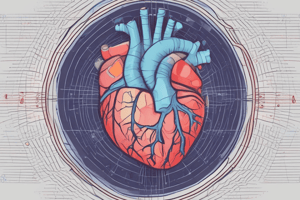Podcast
Questions and Answers
Identify the anatomical structures that make up the cardiac borders on a chest x-ray.
Identify the anatomical structures that make up the cardiac borders on a chest x-ray.
The cardiac borders on a chest x-ray consist of the sternocostal (anterior) surface, diaphragmatic (inferior) surface, right ventricle, left ventricle, right atrium, left ventricle, and the base (posterior) surface.
What are the two separate sides of the heart and their respective functions?
What are the two separate sides of the heart and their respective functions?
The two separate sides of the heart are the right heart and the left heart. The right heart pumps deoxygenated blood to the lungs in the pulmonary circulation, while the left heart pumps oxygenated blood throughout the body in the systemic circulation.
Name the septa and chambers of the heart.
Name the septa and chambers of the heart.
The septa of the heart include the interatrial septum, interventricular septum, and atrioventricular septum. The chambers of the heart include the right atrium, left atrium, right ventricle, and left ventricle.
What are the learning outcomes of studying the internal and surface anatomy of the heart?
What are the learning outcomes of studying the internal and surface anatomy of the heart?
Why are the points of auscultation of heart sounds different from the surface projection of the heart valves?
Why are the points of auscultation of heart sounds different from the surface projection of the heart valves?
What is the functional importance and position of the fibrous skeleton of the heart?
What is the functional importance and position of the fibrous skeleton of the heart?
Name two types of valves in the heart and describe their structure and function.
Name two types of valves in the heart and describe their structure and function.
What is the fibrous skeleton of the heart and what is its function?
What is the fibrous skeleton of the heart and what is its function?
Describe the surface anatomy of the heart.
Describe the surface anatomy of the heart.
What are the two types of muscles found on the ventricle walls and their functions?
What are the two types of muscles found on the ventricle walls and their functions?
What are the causes of ischemic heart disease?
What are the causes of ischemic heart disease?
What are the microscopic features of an atheroma?
What are the microscopic features of an atheroma?
What are the clinical and investigatory features of an acute MI?
What are the clinical and investigatory features of an acute MI?
What is the difference between NSTEMI and STEMI?
What is the difference between NSTEMI and STEMI?
How do we categorize arrhythmias?
How do we categorize arrhythmias?
What is the difference between tachy-arrhythmia and brady-arrhythmia?
What is the difference between tachy-arrhythmia and brady-arrhythmia?
What are the two possible origins of atrial fibrillation?
What are the two possible origins of atrial fibrillation?
What is the characteristic feature of atrial flutter?
What is the characteristic feature of atrial flutter?
What is the treatment approach for atrial fibrillation?
What is the treatment approach for atrial fibrillation?
What is the definition of supraventricular tachycardia?
What is the definition of supraventricular tachycardia?
What is echocardiography?
What is echocardiography?
What is the impact of echocardiography in the field of cardiology?
What is the impact of echocardiography in the field of cardiology?
What are the advantages of echocardiography compared to other imaging techniques?
What are the advantages of echocardiography compared to other imaging techniques?
What is the purpose of the m-mode in echocardiography?
What is the purpose of the m-mode in echocardiography?
What does basic echo in the resuscitation setting aim to answer?
What does basic echo in the resuscitation setting aim to answer?
What are some cardiovascular complications of Marfan's Syndrome?
What are some cardiovascular complications of Marfan's Syndrome?
What is the role of echocardiography in the diagnosis and management of cardiovascular disease?
What is the role of echocardiography in the diagnosis and management of cardiovascular disease?
What are the advantages and disadvantages of echocardiography?
What are the advantages and disadvantages of echocardiography?
What are the different types of transducers/probes used in echocardiography?
What are the different types of transducers/probes used in echocardiography?
What are the imaging windows used in transthoracic echocardiography (TTE)?
What are the imaging windows used in transthoracic echocardiography (TTE)?
Flashcards are hidden until you start studying



